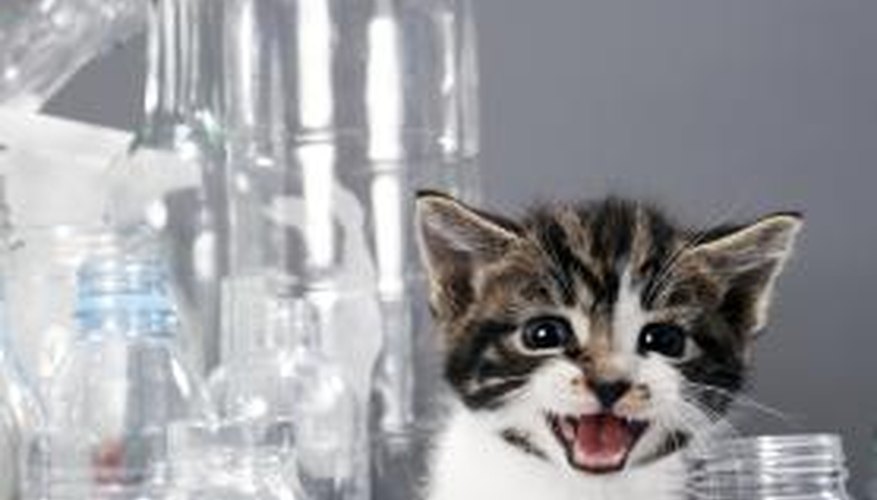One vital element in the lives of humans is plastic. From life-saving equipment to food and beverage containers, plastic bottles appear everywhere you look. You may not know that some plastic bottles cannot be reused and some are not suitable for storage of edible goods. Chemicals found in plastics for making bottles have come under scrutiny, and safety is a concern.
Advantages
Most disposable plastic bottles, since 2010, are made from polythene terephthalate (PET), which the Food and Drug Administration (FDA) considers safe. Plastic bottles are cheap, convenient, lightweight and shatterproof. Most plastic bottles are recyclable.
Disadvantages
Many plastic bottles are not reusable and are not safe for hot liquids or for use in dishwashers or microwaves. Some tougher, reusable plastic bottles may contain Bisphenol A, a polycarbonate believed to cause cancer. The main disadvantage of plastic bottles is that so many of them end up in landfills instead of being recycled. It takes thousands of years for plastic bottles to biodegrade, and the degrading process emits toxic chemicals into the air.
- Many plastic bottles are not reusable and are not safe for hot liquids or for use in dishwashers or microwaves.
- Some tougher, reusable plastic bottles may contain Bisphenol A, a polycarbonate believed to cause cancer.
Number System
On or near the bottom of plastic bottles is a number within a triangular recycling symbol. This number tells you what the bottle is made of, how it will affect your health and whether or not it is reusable. Most #1 plastic bottles used for soda and water are safe for initial use, but are disposable and should not be reused because the plastic is porous, allowing bacteria and flavour to accumulate.
#2 Plastics
Bottle made from #2 plastic, high density polythene (HDPE), include milk jugs, household chemical bottles, juice bottles, butter tubs and toiletry bottles. This type of plastic is considered safe and recyclable but may not be durable enough for reuse.
#3 Plastics
Plastic #3 is polyvinyl chloride (PVC) and used to make food wrap, cooking oil bottles and plumbing pipes. PVC contains phthalates, a softening chemical that interferes with hormones. Food contact with #3 plastic should be avoided, and it should never be used in the microwave. Plastic #3 bottles are not usually recyclable.
- Plastic #3 is polyvinyl chloride (PVC) and used to make food wrap, cooking oil bottles and plumbing pipes.
- Food contact with #3 plastic should be avoided, and it should never be used in the microwave.
#4 Plastics
Plastic #4, used in the production of grocery bags, food wraps, bread bags and squeezable bottles, is considered food safe and reusable but usually not recyclable. This plastic is made from low density polythene (LDPE).
#5 Plastics
Polypropylene plastic bottles, labelled #5, are wide-necked food containers, such as yoghurt cups and some water bottles. Medicine bottles, ketchup bottles, straws and syrup bottles made from #5 plastic are safe and reusable and are accepted by some recycling facilities.
#6 Plastics
Although not used for bottles, #6 polystyrene, or styrofoam, comes in contact with food in the form of disposable plates and cups. Controversy over this type of plastic has increased in recent years. This type of plastic is not biodegradable or recyclable. Increasing evidence suggests that #6 plastic, when heated, leaches potentially toxic chemicals into food. Placing hot food on a styrofoam plate may be hazardous to your health.
- Although not used for bottles, #6 polystyrene, or styrofoam, comes in contact with food in the form of disposable plates and cups.
- Increasing evidence suggests that #6 plastic, when heated, leaches potentially toxic chemicals into food.
#7 Plastics
Plastic baby bottles and food containers labelled #7 are a mixture of plastics, including hazardous BPA. Plastic #7 is tough and reusable and resists staining, but it is not recyclable. Baby bottles labelled with #7 should be discarded and you should avoid purchasing food and beverages in #7 plastic containers and bottles. Transfer foods purchased in #7 plastic containers to a safe container before heating.
- Plastic baby bottles and food containers labelled #7 are a mixture of plastics, including hazardous BPA.
